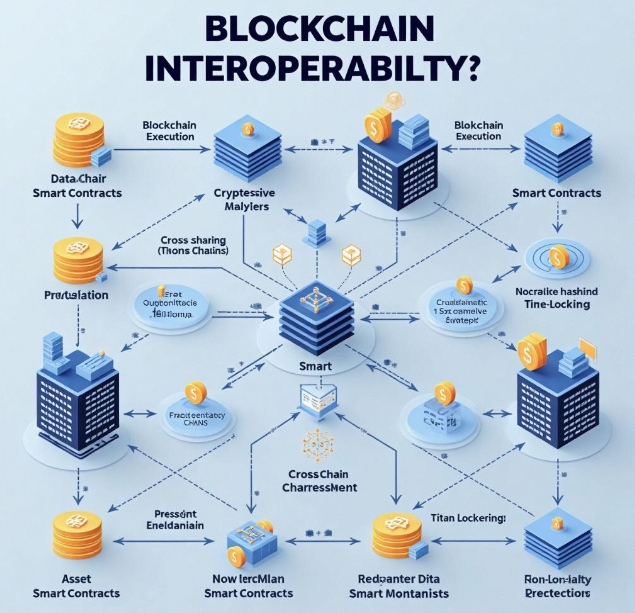How to Achieve Cross-Chain Interaction in DApps? An Analysis of Blockchain Interoperability
- latest articles
- 1.DApp Development & Customization: Merging Diverse Market Needs with User Experience 2.Analysis of the Core Technical System in DApp Project Development 3.How to achieve cross-chain interoperability in Web3 projects? 4.How does the tokenization of points reconstruct the e-commerce ecosystem? 5.How to Set and Track Data Metrics for a Points Mall? 6.What is DApp Development? Core Concepts and Technical Analysis 7.Inventory of commonly used Web3 development tools and usage tips 8.Development of a Distribution System Integrated with Social E-commerce 9.Six Key Steps for Businesses to Build a Points Mall System 10.What is DApp Development? A Comprehensive Guide from Concept to Implementation
- Popular Articles
- 1.Future Trends and Technology Predictions for APP Development in 2025 2.Analysis of the DeFi Ecosystem: How Developers Can Participate in Decentralized Finance Innovation 3.From Zero to One: How PI Mall Revolutionizes the Traditional E-commerce Model 4.DAPP Development | Best Practices for Professional Customization and Rapid Launch 5.Recommended by the Web3 developer community: the most noteworthy forums and resources 6.From Cloud Computing to Computing Power Leasing: Building a Flexible and Scalable Computing Resource Platform 7.How to Develop a Successful Douyin Mini Program: Technical Architecture and Best Practices 8.Shared Bike System APP: The Convenient Choice in the Era of Smart Travel 9.How to Create a Successful Dating App: From Needs Analysis to User Experience Design 10.From Design to Development: The Complete Process of Bringing an APP Idea to Life
With the continuous development of blockchain technology, an increasing number of decentralized applications (DApps) are emerging. Due to their advantages such as decentralization, security, and transparency, DApps are gradually being widely applied in various fields like finance, supply chain, and gaming. However, with the rise of different blockchain platforms, how to enable the flow of data and value across multiple blockchains has become an urgent issue to address. Cross-chain technology, as a core component of blockchain interoperability, is gradually paving the way for collaboration between different platforms in the blockchain world. This article will delve into the concept of cross-chain interaction, technical solutions, and how to implement cross-chain interaction in DApps.
I. Overview of Blockchain Interoperability
Blockchain interoperability refers to the ability of different blockchain platforms to seamlessly exchange information and value. Currently, there are many different blockchain platforms in the market, such as Ethereum, Bitcoin, Polkadot, and Cosmos. These platforms vary in consensus mechanisms, smart contract languages, and network architectures, leading to poor interoperability between them. To enable the free flow of data, assets, and information between these blockchain platforms, an effective cross-chain technology is required.
Blockchain interoperability mainly includes the following aspects:
Cross-Chain Assets: Cross-chain technology enables the transfer and trading of digital assets across different blockchains. For example, transferring Bitcoin to the Ethereum network or exchanging assets between Polkadot and Ethereum.
Cross-Chain Information: Cross-chain information primarily refers to the ability of different blockchain networks to share data or events. For instance, when a smart contract on Ethereum executes, it can notify smart contracts on other chains to trigger related operations.
Cross-Chain State: Even if assets and information can be exchanged between chains, inconsistencies in state may arise across different blockchains. Cross-chain technology needs to ensure state consistency.
II. Cross-Chain Interaction Needs in DApps
In DApp development, the need for cross-chain interaction is becoming increasingly important. Traditionally, DApps often rely on the infrastructure of a single chain, such as Ethereum. However, with the continuous expansion of application scenarios like decentralized finance (DeFi), NFTs, and cross-chain trading, DApps also face the challenge of how to leverage the advantages of multiple blockchains.
The main needs for cross-chain interaction in DApps include:
Cross-Chain Asset Transfer: For DApp users, the ability to freely transfer assets between different blockchain platforms (e.g., from ETH to BSC) is an important need. This allows users to better utilize the advantages of low transaction fees and high throughput on different chains.
Data Interoperability: DApps may need to access data from multiple chains. For example, in a cross-chain DeFi application, it may be necessary to obtain liquidity, asset prices, and other information from multiple chains to optimize trading strategies.
Cross-Chain Smart Contract Execution: Smart contracts in DApps often involve complex interactions and may need to collaborate with contracts on other chains to complete a transaction or execute a function.
Privacy and Security: Cross-chain interaction involves information exchange between different chains, so ensuring data privacy and security and preventing cross-chain attacks are urgent issues to address.
III. Cross-Chain Technology Solutions
Currently, cross-chain technology has made significant progress, with multiple technical solutions proposed to achieve interoperability between different blockchains. The following are several common cross-chain technologies:
1. Relay Chain
A relay chain connects different blockchains through an independent blockchain (the relay chain) to achieve cross-chain operations. Polkadot is the most well-known relay chain project. Polkadot's architecture consists of a relay chain and multiple parachains. The relay chain is responsible for validating the state of all parachains and ensuring interoperability between them. The relay chain uses the Cross-Chain Message Passing (XCMP) protocol to enable communication and asset transfer between different parachains.
In DApps, cross-chain interaction can be achieved by connecting to a relay chain. For example, in a Polkadot-based DApp, users can transfer assets and exchange data between Ethereum and Polkadot through the relay chain.
2. Atomic Swap
Atomic swap is a trustless trading method that allows users to exchange assets between different blockchains. For example, an atomic swap between Bitcoin and Ethereum enables users to trade without relying on centralized exchanges. Atomic swaps work by using Hashed Timelock Contracts (HTLCs) to ensure the security and fairness of transactions.
In DApps, atomic swaps can be used to achieve asset transfers between different blockchains. For instance, users can perform asset swaps between Ethereum and Bitcoin via atomic swaps without relying on a central exchange platform.
3. Cross-Chain Bridge
A cross-chain bridge enables interaction between different blockchains through a "bridge contract" or "cross-chain protocol." Cross-chain bridges typically consist of two main components: one contract for locking assets and another for releasing assets. Through a cross-chain bridge, users can transfer assets from one blockchain (e.g., ETH) to another (e.g., BSC).
Many DApps rely on cross-chain bridges for asset transfers. For example, users can transfer ETH from the Ethereum network to Binance Smart Chain via a cross-chain bridge, enabling transactions on a chain with low transaction fees. Notable cross-chain bridge projects include Thorchain, Ren Protocol, and Polygon's bridging services.
4. Sidechains
Sidechains are independent blockchains connected to a main chain (such as Bitcoin or Ethereum) through a mechanism that allows assets to flow between them. Interaction between sidechains and the main chain is typically achieved through locking and releasing mechanisms.
DApps can leverage sidechains to enhance their performance and scalability. For example, many Ethereum-based DApps (such as Decentraland) use sidechains to handle complex computations and transactions, reducing the burden on the main chain.
5. Decentralized Exchange Protocol (DEX)
Decentralized exchange protocols (DEXs) provide cross-chain trading services, enabling direct asset exchanges between different blockchains. Through DEXs, users can conduct cross-chain transactions on a single platform without the need for multiple intermediaries or centralized platforms.
For example, Cosmos's IBC (Inter-Blockchain Communication) protocol enables transactions between different blockchains in a decentralized manner. The Cosmos SDK allows blockchain developers to create applications compatible with other blockchains, and users can perform cross-chain transactions via the IBC protocol.
IV. How to Implement Cross-Chain Interaction in DApps?
Implementing cross-chain interaction in DApps typically requires developers to combine multiple cross-chain technology solutions. Below are some key steps:
1. Choose the Appropriate Cross-Chain Protocol
DApp developers need to select the appropriate cross-chain protocol based on their application requirements. For example, if asset transfer between Ethereum and Polkadot is needed, they might choose Polkadot's relay chain technology; if low transaction fee cross-chain trading is desired, cross-chain bridge technology can be used.
2. Integrate Cross-Chain Bridges or Atomic Swaps
Once a cross-chain protocol is selected, developers need to integrate cross-chain bridges or atomic swap protocols into the DApp. This typically involves interacting with the cross-chain protocol's API or implementing related functions in smart contracts.
For example, developers can integrate the smart contracts of a cross-chain bridge into the DApp's user interface, allowing users to easily transfer assets with a click of a button. Alternatively, they can implement atomic swap protocols in the DApp to ensure secure and efficient asset exchanges between different chains.
3. Ensure Security
Cross-chain interaction may introduce certain security risks, especially when transferring assets between multiple blockchains. Developers need to ensure appropriate security measures are taken when designing cross-chain interactions. For instance, using encryption to ensure data security, designing hash time-lock mechanisms to ensure fairness in asset transfers, and preventing potential double-spending attacks.
4. Optimize User Experience
Cross-chain interaction may increase the complexity of user operations, so it is necessary to provide a simple and user-friendly interface. For example, DApps can offer users a cross-chain asset management panel, allowing them to intuitively view and manage their cross-chain assets.
V. Summary
Blockchain interoperability and cross-chain interaction are important topics in decentralized application (DApp) development. With the continuous advancement of blockchain technology, cross-chain technology has evolved from theory to practice, and multiple cross-chain solutions such as relay chains, atomic swaps, cross-chain bridges, sidechains, and decentralized exchange protocols have been proposed and applied. Through these technologies, DApps can achieve seamless interaction between different blockchains, providing users with more convenient and secure decentralized services.
In the future, as cross-chain technology continues to mature, we can anticipate that blockchain interoperability will be greatly enhanced, and DApp functionalities will become more diverse and rich. Cross-chain interaction will not only improve the user experience but also drive the development of the entire blockchain industry, promoting collaboration and integration between different blockchains.
-

DApp Development & Customization: Merging Diverse Market Needs with User Experience
As blockchain technology matures and becomes more widespread, decentralized appl···
-

Analysis of the Core Technical System in DApp Project Development
With the rapid development of blockchain technology, decentralized applications ···
-

What is DApp Development? Core Concepts and Technical Analysis
With the rapid development of blockchain technology, decentralized applications ···

 Blockchain
Blockchain












